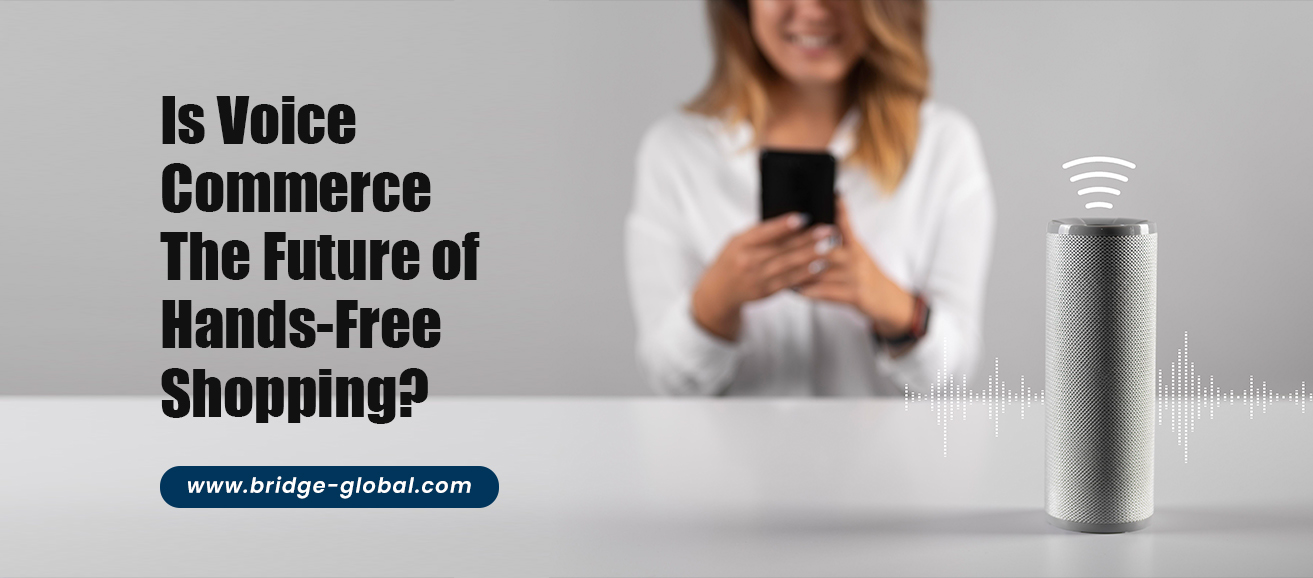AI and Voice Commerce: The Future of Hands-Free Shopping
Voice commerce has swiftly evolved from a sci-fi fantasy into a powerful commerce channel, reshaping how consumers experience shopping. At its core, voice commerce thrives on convenience: the ability to buy, reorder, or discover products with nothing more than your voice. Driven by advanced voice commerce AI, this mode of shopping is becoming a cornerstone of ecommerce innovation.
As consumers demand more seamless shopping experiences, businesses are adapting by investing in ecommerce development services and partnering with AI development services specialists. The result? Voice-activated shopping assistants that feel both intuitive and instantly accessible.
The Rising Tide of Voice Shopping Assistants
The growth of voice commerce is being shaped by the widespread adoption of voice-enabled technologies and the increasing reliance on conversational interfaces. As more users become comfortable with voice-driven interactions, shopping through voice shopping assistants is becoming a natural extension of daily life.
These assistants are no longer viewed as novelty tools but as trusted digital companions capable of guiding the shopping journey from start to finish. They simplify product discovery, manage reorders, and even complete purchases, making the experience intuitive and efficient. With advancements in voice commerce AI, these assistants are moving toward delivering interactions that feel personalized, context-aware, and secure, ensuring customers view them as reliable partners in digital commerce.
How AI Enhances Voice Commerce

1. Utter Convenience & Accessibility
The clearest advantage of voice commerce is convenience. Consumers can place orders while cooking, driving, or when their hands are full or occupied - no typing required. For those with mobility constraints, or limited access to traditional interfaces, voice offers an egalitarian access route. The benefit is immediate: shorter time to order, less friction, fewer abandoned carts. Enterprises working with ecommerce development services are integrating voice-enabled checkout and product discovery features to capture demand at the exact moment it arises.
2. Hyper-Personalization
Thanks to underlying AI models (speech recognition, natural language processing, predictive analytics), voice commerce AI systems can personalize interactions in ways mere visuals cannot. These assistants analyze past behavior, preferred brands, frequency of purchase, and even seasonal tendencies to suggest products conversationally. Whether via voice prompts (“Would you like to reorder your shampoo?”) or real-time suggestions during search or reordering, personalized voice shopping feels more like speaking with a helpful friend than interacting with software.
3. Frictionless Checkout
One of the hurdles in traditional web-based shopping is the friction of input - typing, filling forms, selecting numerous options. Voice commerce helps skip many of those steps. For repeat purchases, customers can confirm with voice anything from quantity to shipping instructions. In association with AI development services and strong backend integration, even payments can be streamlined; though payment security and authentication are still active areas of concern and development.
4. Inclusive User Experience
Modern voice shopping assistants aren’t limited to one accent or dialect. As technology improves, voice commerce platforms are aiming to understand natural, colloquial speech, support multiple languages, and handle accents or informal speech. For global businesses, this means opening up markets previously underserved by typed interfaces. Inclusivity is no longer optional, it’s central to both design and adoption.
5. Real-Time Assistance and Support
With AI powering voice commerce, users can ask about availability, get product details, compare prices, check delivery timelines - all via voice. The ability to respond in real time to queries increases transparency. When customers feel informed, they are more likely to trust and complete transactions. Brands are investing in tools that integrate voice-activated support into their workflows to reduce support ticket loads and improve satisfaction.
What Lies Ahead for Voice Commerce

IoT Integration
Voice commerce is expanding beyond smart speakers into every connected device. From cars and fridges to AR/VR platforms, consumers will be able to shop using voice across a seamless device ecosystem.
AI-Powered Insights
AI’s ability to analyze voice data yields powerful insights into shopper behaviors, from emotional tone to purchasing patterns. Retailers can use this to fine-tune offerings and marketing in real time.
Secure Voice Payments
Voice authentication is gaining traction. Biometric voice recognition and voiceprint security are transforming voice-based checkouts into secure, fast, and reliable transactions.
Voice-First SEO and Content
To succeed in voice commerce, retailers must rethink how product data and content are structured. Natural-speech SEO, concise voice-friendly descriptions, and long-tail phrases will become critical to visibility.
Role of AI Development and Ecommerce Development Services

Organizations looking to embrace voice commerce need partners who understand both ecommerce systems and AI infrastructure. Ecommerce development services must integrate secure voice interfaces, payment processing, fulfillment workflows, and APIs that expose product catalogs in voice-friendly formats. Meanwhile, AI development services create capabilities such as speech recognition, natural language understanding, personalization, and voice-led analytics.
True differentiation comes when a business blends these competencies. Skilled voice shopping assistants built with strong AI models, maintained through robust backend services, and integrated seamlessly into customer journeys (discovery, checkout, post-purchase) offer experiences that feel delightful and effortless. Brands investing in “AI Super Agents” that combine voice-guided shopping, customer support, and even inventory insights are already gaining the edge.
Challenges to Address & How to Mitigate Them
As voice commerce continues to evolve, businesses face hurdles that could hinder adoption and trust if left unaddressed. From accuracy issues to security concerns, understanding these challenges and knowing how to mitigate them is crucial for long-term success.
1. Speech Recognition Accuracy
Voice commerce relies heavily on accurate speech recognition, but accents, slang, and background noise can reduce reliability. Misinterpretations frustrate customers and erode trust, limiting adoption unless businesses actively address the issue through better technology and user-friendly design.
- Invest in advanced NLP and machine learning models that continuously adapt to regional accents, colloquial phrases, and diverse speech patterns.
- Conduct extensive real-world testing across varied environments to ensure reliability under noisy or challenging conditions for all demographics.
2. Privacy and Security Concerns
Consumers worry about always-listening devices and unauthorized purchases. Data misuse or breaches could quickly undermine the credibility of voice commerce platforms, creating hesitation to adopt them despite their obvious convenience and personalization benefits.
- Implement transparent privacy controls that allow users to manage recording preferences and delete stored data anytime.
- Use multi-layer authentication, including voice biometrics, passcodes, or confirmations for sensitive or high-value transactions.
3. Backend and Payment Integration
Legacy systems and fragmented ecommerce backends can make it difficult to seamlessly integrate voice commerce AI with order fulfillment, payment processing, and customer records. Without robust integration, the experience feels inconsistent and discourages repeat usage.
- Partner with ecommerce development services experienced in merging voice interfaces with diverse back-end systems, APIs, and payment gateways.
- Prioritize modular, scalable architectures that allow future upgrades without breaking existing integrations.
4. User Trust and Comfort
Some consumers are still hesitant to complete purchases without visual confirmation. Lack of confidence in a “voice-only” process can cause reluctance to explore advanced features or complete high-value transactions through voice interfaces.
- Provide hybrid interfaces that allow easy switching between voice and visual confirmation for sensitive purchases.
- Educate users through onboarding experiences that highlight voice security, reliability, and step-by-step confirmations.
Bottom Line: Voice Commerce Is the Future
Voice commerce, once experimental, is now a proven, expanding channel powered by AI. With soaring user adoption, higher conversion rates, and rising tech maturity, voice is becoming a key frontier of ecommerce innovation. From seamless voice orders via car dashboards to personalized voice assistants that remember your preferences, voice is unlocking convenience and engagement like never before.
To stay competitive, businesses must partner with ecommerce development services and AI development services that understand voice’s nuances. The future of shopping isn’t just about convenience - it’s human, hands-free, and sentimentally smart. Voice commerce is redefining the meaning of effortless shopping - and it's just getting started.



